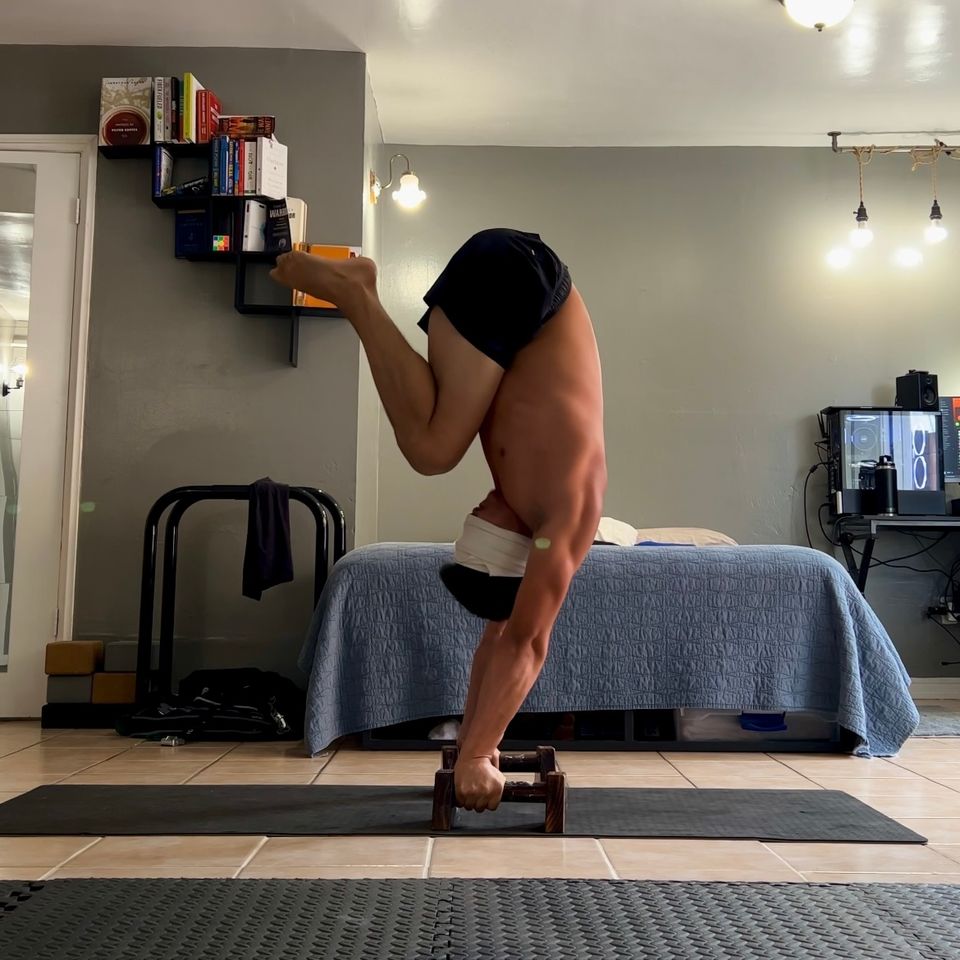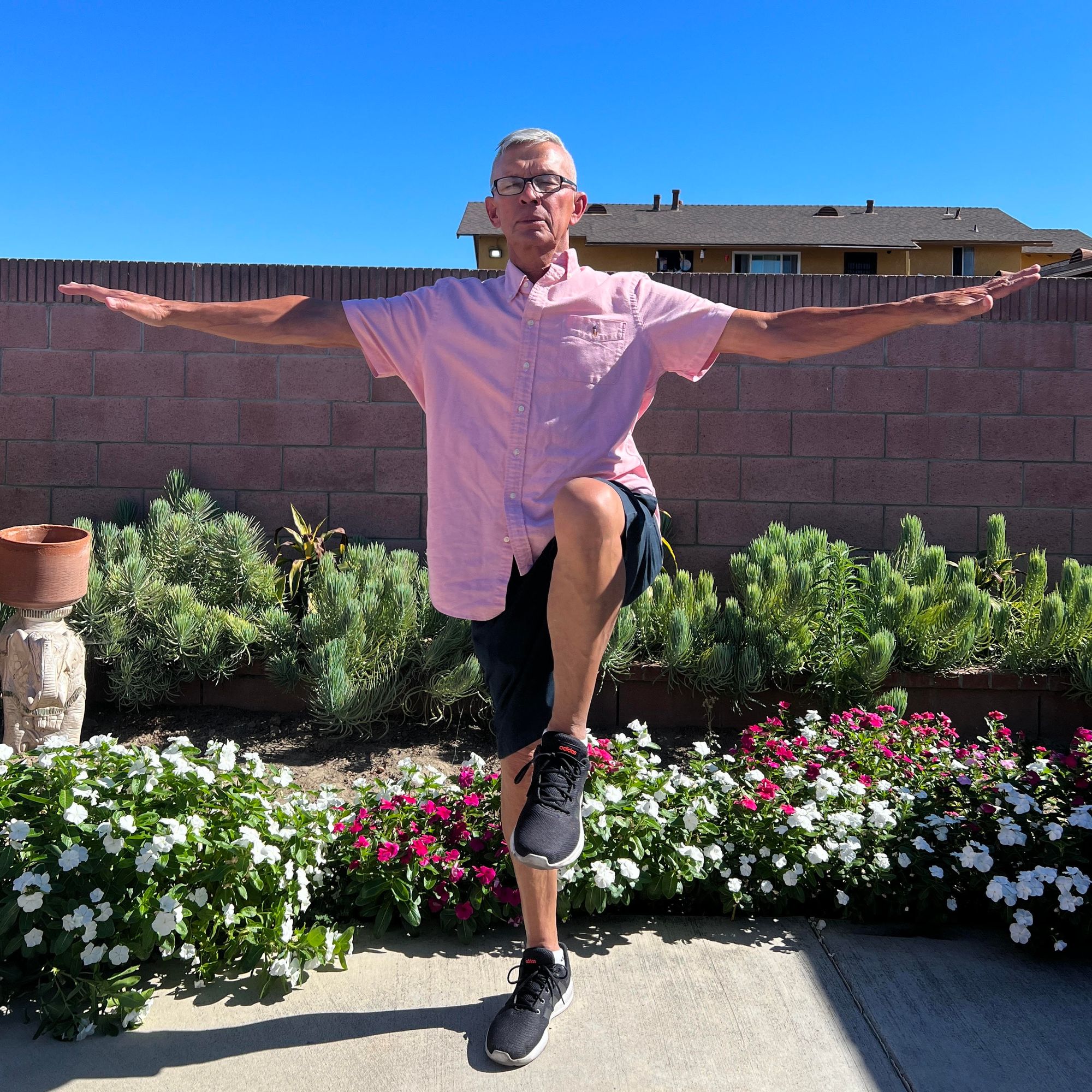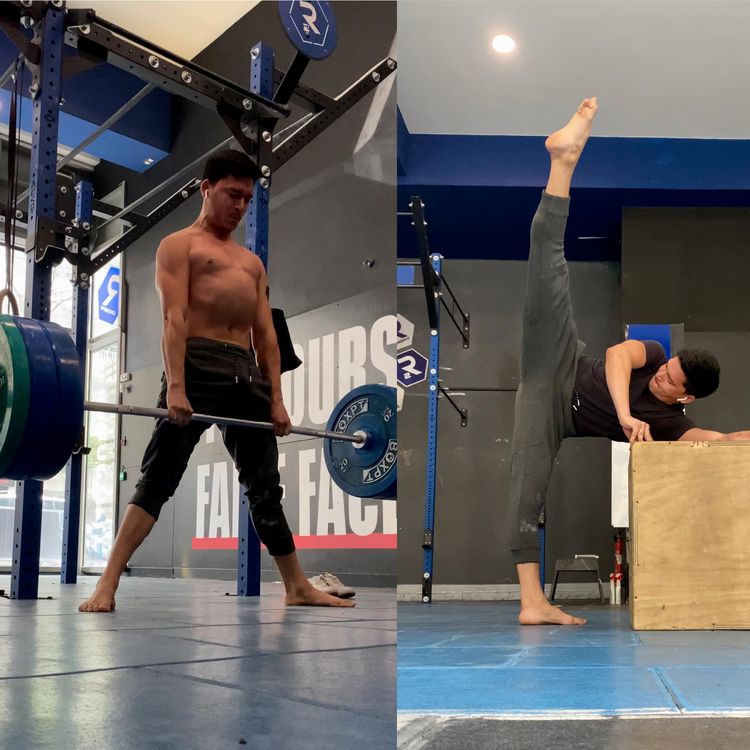Blindfolds For Handstands. Tool or Trick?

My thoughts on how blindfolds can be used as a tool to challenge your handstand practice.
I'd say both!
Handstands are a skill
We can define a skill as a movement that displays qualities from multiple motor abilities. And there's 6 motor abilities that humans possess. Strength, endurance, agility, speed, coordination, and flexibility. The more motor abilities that a skill requires, the more complex and difficult the skill is. Handstands require more than one of these motor abilities and so I like to think of handstands as a skill. As they become more advanced, they'll require more motor abilities and each of them get more complex.
Take the below bendy straddle handstand below as an example. To hold myself upside down, I must be able to exert enough force through my shoulders and arms into the ground, this is an element of strength. To bend my back into the "hollowback" shape and open my legs into the straddle, I need the active flexibility. Speed and agility aren't at play here, but if the handstand is long enough, it will have an element of endurance. And lastly, balancing the handstand, orienting my body in space, and synchronizing the individual movements is an example of the motor ability coordination. Now we understand why handstands are a skill!

Minimizing training variables
When it comes to learning and training for complex skills, it's important to distill the skill into individual, bite size pieces that can be worked on independently. An example of this would be training the balance component of handstands separate from the strength, separate from the endurance...flexibility...and so on...This is key for progress.
The next thing we like to do is to minimize environmental training variables where possible. It's common for handbalancers to have OCD-like tendencies like always training in the same room, in the same corner, in the same socks, on the same handstand board, playing the same playlist, over and over again. Why is this?
It's because handstands are a complex skill!
By repeatedly training under the same environmental conditions, we're minimizing how much processing power our brain is using, and this makes the skill training more manageable. The brain can focus less on external factors and more on the actual skill.
This is all great when learning and I so often encourage it. But there will come a time when your handstand is much more confident and balance starts to take much less mental power. It starts to become second nature and feels more like muscle memory rather than a big effort.
At this point, it can be quite useful to introduce other aspects into your training that challenge your mind and body. Introducing new mental aspects into your training can help take your handstand to new levels. These can be things like handstands from a height, handstands in new environments, or even handstands in front of people. Each of these will pose a new demand on your handstand.
The blindfold is another tool that we can use to challenge the mental aspect of our handstand.
How vision and balance are linked
We first need to understand the role that vision plays with balance and what better way than running a quick and dirty test!
Try standing on one leg with the other leg raised and hands held out to the side. After you find your balance, close your eyes and see what happens. Seems easy, right? I highly encourage you to stand up and try, you might be surprised at what you find 😉.
Try it with family and friends if you're keen! Below is a picture of my dad giving the test a try.

Interesting, right?!
For humans to balance, our brain needs to take in and assimilate information from three sensory systems. These three systems are our:
- Visual system - our eyes
- Vestibular system - our inner ears
- Proprioceptive system - information from our muscles and joints to give us an understanding of where we are in space
The intimate relationship between these three systems is what allows us to live our lives the way we know it. Take away one of these systems and life can get challenging. Particularly our balance. Hence why the standing balance test gets pretty difficult as soon as we close our eyes. One way to think of it is that vision guides balance.
When we are upside down, our brains' proprioceptive abilities are challenged. Thus impacting our ability to balance. Take away vision using a blindfold and balancing a handstand becomes exponentially more difficult!
Can blindfolded handstands be a useful tool?
Now that we've covered how introducing new mental aspects to our handstand practice can improve the skill of hand balancing, and how vision plays a significant role in our ability to balance, we can begin to see how introducing a blindfold to a handstand practice may actually be a useful tool.
When we take away an entire sensory system while upside down, we're forced to rely heavily on our other two sensory systems. Over time, this will improve those sensory systems such that when we reintroduce vision, our overall ability to handstand will be improved.
3 ways to use blindfolds in your practice
There are many ways to introduce a blindfold into your training. Below I'll list a procedural way you can use to implement the blindfold.
- On the wall - Like with all things handstand, it's never a bad idea to start on the wall. Choose your favorite wall-friendly balance exercise and try it blindfolded. I'd recommend going for something like a chest-to-wall balance with split legs or with legs together and aiming to balance for 10-15s.
- Freestanding - If balancing off the wall was easy, time for freestanding holds. Straight will be the most difficult as it's the longest position. So if you find that it's easier to balance shapes other than straight without a blindfold, such as straddle/tuck/split leg, then I'd recommend starting there.
- For tricks - here's where we can start to have fun! Explore balancing your toughest and most creative tricks. Cartwheel to handstand, head-in handstands, bendy shapes, hips twists. The world is really your oyster!
The party trick
I’m gonna put the combo of handstanding blindfolded and sniffing my knees in the party trick category 😂
While having the ability to sniff your nose in a handstand does display some desired qualities for a strong handstand, such as strength in shoulder elevation and protraction and a strong tuck, it's not at all a requirement for a well rounded and advanced level of handstand. I've met many hand balancers that are leagues better than me that can't sniff their knees. There are other factors that come into play here such as morphology.
And that's why I place it in the party trick category!
If you're curious about what it looks like, you can check out the video below to see me doing the trick 😊.
The Bottom Line
To wrap things up, we learned that vision plays a huge role in our ability to balance. We learned why handstands are classified as a skill and how adding a blindfold to your handstand practice will immediately make balance significantly more challenging. It will test your handstand abilities and can in fact be a useful tool for improving the skill of handstands. If you feel like you might be ready, give it a try! What’s to lose anyways? Handstands are meant to be fun! 😊
As always, happy training!
Los
If you enjoyed this article and are interested in learning more about similar topics, I encourage you to subscribe to my weekly newsletter, The Sunday Spread, where I share training tips, discounts to my coaching services and elaborate on articles like this one here.
You can sign up by hitting the gray button in the bottom right-hand corner and dropping your email! I can also be reached through my contact form found here.





